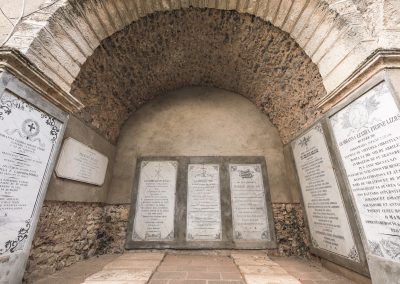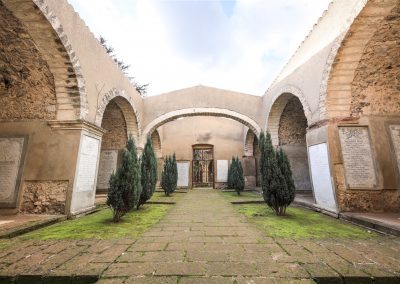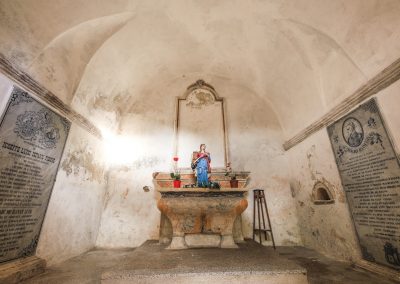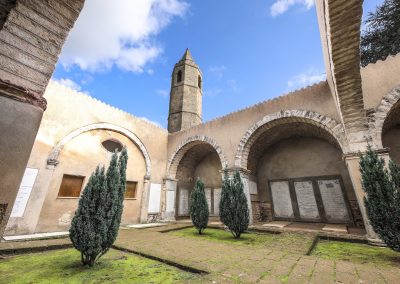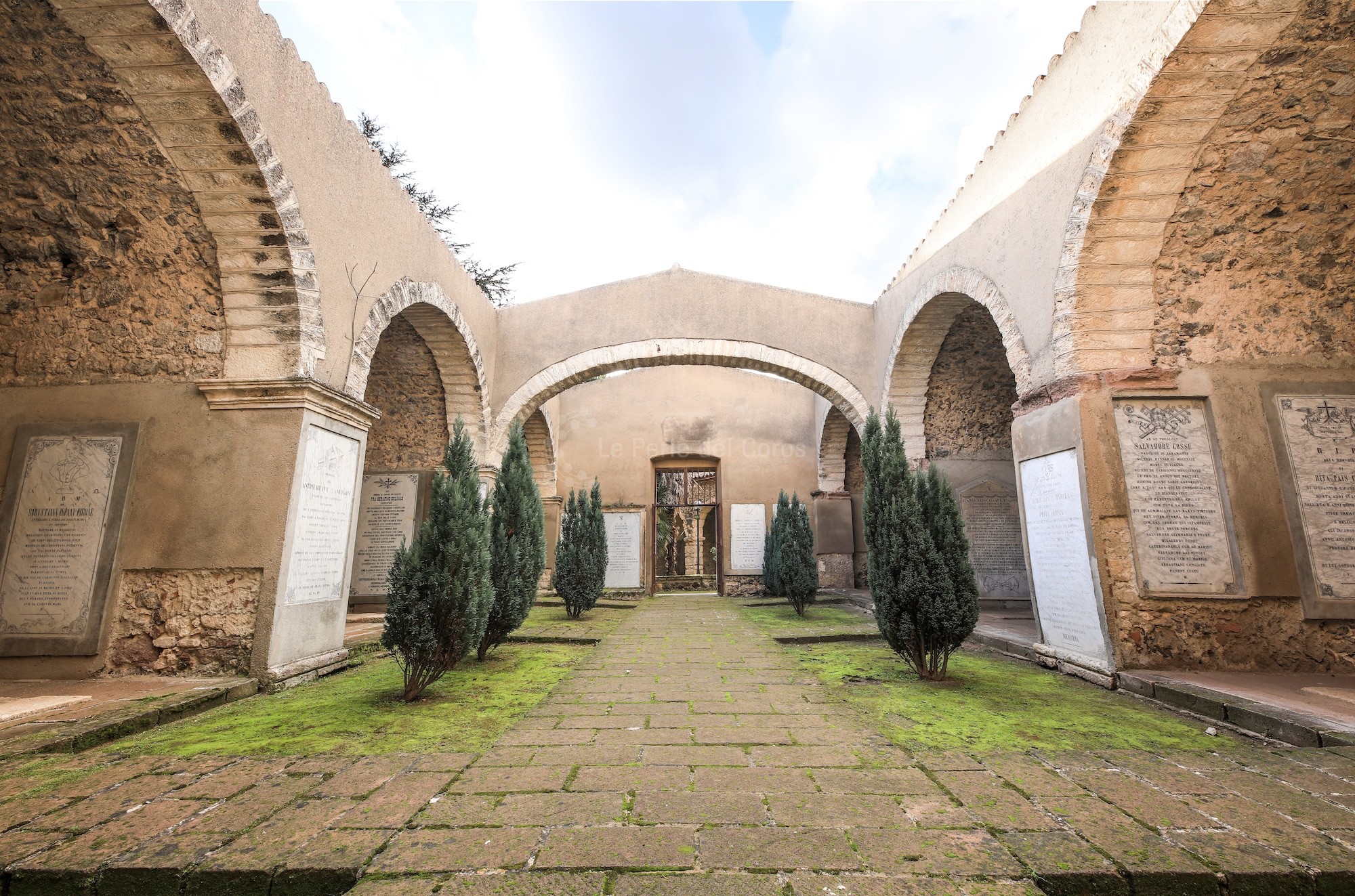
Ploaghe
Monumental cemetery
The Monumental Cemetery, also called “Camposanto Vecchio” in Italian or “Tzimitòriu” in Sardinian (tn* old cemetery), is the oldest cemetery in Sardinia. It is of great relevance because it was blessed in 1797, as recorded by the Canon Spano, well before the Edict of Saint-Cloud in 1804; after which, for example, the historic cemetery of Bonaria in Cagliari was established. The Monumental Cemetery is the only one to have kept gravestones written in Sardinian, in the Logudoro variant. It is located in an area called “Cortile de Cheia”, adjacent to the Oratory of the Rosary and the church of Saint Peter from which, surprisingly, it is totally separated. The building is located on Town Council property and belongs to it, both the structure and gravestones. It is separated from the Town Cemetery, which was built in a peripheral area on the other side of the town, in accordance with regulations, after a cholera epidemic hit Ploaghe in 1855. According to the historian Lamarmora “It is the oldest in Sardinia and also the most beautiful” (tn* translation of quote in Italian). In an article published in “Ichnusa in 1949, the architect Vico Mossa” boasts about its mystical and spacious simplicity. It was designed by the rector D. Salvatore Ravaneda in 1792 and blessed by the rector Gavino Strina in 1797. This was before the construction of the cemeteries in Cagliari and Sassari, the first dating back to 1829 and the second to 1836. The area chosen had surrounded the church of Saint Peter for centuries, the same area where Monsignor Alepus absolved all the dead in 1552 and where Monsignor Morillo covered the charnel house in 1668. The small church of Saint Barbara was also included in the cemetery grounds. Of the church, which was built by order of the rector Strina, the capitals of the doorjambs and the architrave in the chapel of the Holy Cross remain today. In 1824 the graveyard contained 70 graves, excluding those of children. Despite the fact that the cemetery was blessed in 1797, the first burial belongs to Basilio Fais, who had died at the age of 20 on November 14th 1794, before the graveyard was completed. This important innovative cemetery had certainly earned the approval of the Archbishop Della Torre who, on May 27th 1794, signed the register of the dead. Therefore, the old Cemetery existed before the Viceroys’ proclamations forbidding burials inside church walls, throughout Sardinia. From an architectural point of view, the construction consists of an open square, flanked by six arches, covered by vaults, three per side, closed at the front by the chapel of the Holy Cross, with an altar blessed with the papal seal of Pope Pius VII on December 6th 1814. In 1859, the Canon Spano published a monograph where he briefly describes the architecture and the history of the graveyard, copying some the epitaphs carved into the white marble gravestones, almost all written by the rector Cossu since 1844. Besides the peculiar architectural structure, the most prominent feature is the conservation of the epitaphs in perfect Logudorese, Sardinian language spoken in the northern region of Logudoro. The oldest one dates back to April 11th 1844 and mentions Iohan Marial Spanu Lizos of Piaghe, 93 years of age, “massaiu bene costumadu, pacificu, laboriosu et iustu” (tn* in Sardinian, “A well educated, peaceful, hardworking and righteous farmer”). The footnote reads “Gasi Deus beneighet ad quielutimet et amat” (tn* May God bless who fears and loves him”). In 1859 there were 18 epitaphs, more were added until the end of the 19th century. Today, after the renovation work, there are 39, three are in Italian, those of Donna Lucrezia Delitala Dies, Don Giacomo Dies and Friar Serafino Solinas. Eight of the gravestones written in Sardinian mention relatives of Canon Spano, including his mother and father, who both died at the age of 93. The cemetery continued to be officiated, at least occasionally, until the middle of the last century.
The monumental cemetrery was renovated in 1982 by the Soprintendenza ai Beni Ambientali, Architettonici, Artistici e Storici, a Public Organisation that governs Environmental, Architectural, Artistic and Historical Heritage, that has recognised its historical and cultural value. Today, the area inside the cemetery lacks lighting and isn’t accessible to disabled people because of some steps located at the entrance. The gravestones, organised both vertically and horizontally, show signs of weathering just like the internal paths, while the green areas have been neglected for a long time. The renovation project included in the territorial plan “Coros Anglona, land of Tradition”, involves the renovation of the monumental cemetery, in order to restore a cultural attraction of such important original beauty and guarantee its accessibility.
- Tomb of the Giants Fiorosu
- The Candelieri
- Church of Saint Peter
- Church of Saint Anthony of Salvennor
- Church and convent of Saint Anthony of Padua
- Church of Saint Michael of Salvennor
- Monumental cemetery
- Funtana Manna (tn* Big Fountain)
- The Oratory of the Rosary
- Church of Saint Matthew
- Nuragic Fountain of Frades Mareos

